The Road to Glory
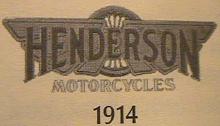
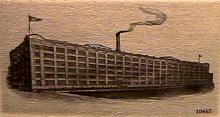
1914
Other than offering a two-speed rear hub as an option, the 1914 Henderson was largely similar to the 1913 model. The 1914 Henderson did feature a saddle plate, which allowed the rider to adjust the saddle-spring tension to his or her own weight. The plate improved the comfort of the ride and lowered the saddle position another inch. In advertising, Henderson continued to promote its motorcycle as exceptionally comfortable and vibration-free.
Excelsior also offered its first two-speed model in 1914, using a planetary gearset. Both the single and the two-speed Excelsior twins were fitted with a heavier, leaf-spring front fork.
 Excelsior returned to the single-cylinder market again in 1914, offering the Lightweight, its first two-stroke machine, with a 15 cubic inch (250 cc) engine. The Lightweight was a single-speed that used a notched flat belt for power transmission.
Excelsior returned to the single-cylinder market again in 1914, offering the Lightweight, its first two-stroke machine, with a 15 cubic inch (250 cc) engine. The Lightweight was a single-speed that used a notched flat belt for power transmission.
Excelsior moved into its new factory--the worlds largest motorcycle manufacturing facility--at 3703 Courtland Street, Chicago, Illinois, in 1914. The sixty story reinforced concrete building was designed throughout for the efficient and economical production of motorcycles. With the largest possible proportion of glass walls to ensure good lighting, a filtered air ventilation system, and even a test track on its roof, it was one of the finest manufacturing facilities in any industry.
In April, Excelsior's Bob Perry defeated Charles Balke to win the 5-mile National Championship in Sacramento, California. In May, Excelsior rider Carl Gouldy won the 10-mile professional race in Philadelphia, Pennsylvania. And, at the two-day meet in Chicago that month, Bob Perry raccked up victories repeatedly in the strickly stock class.
In July, at the meet in Staint Louis, Missouri, Excelsior riders won all three National Championships and half of all the events. Excelsior rider Joe Wolters took the One-Hour Championship held in Birmingham, Alabama on October 8th. In the amateur arena, the National Championship for 1914, W.A. Lauders, won the St. Louis meet on his Excelsior.

Excelsior made major design changes in its existing models' performance and appearance in 1915. The Company also incorporated those changes into a new model, the "Big Valve X." The Big Valve X had a 61 cu. in. engine and Excelsior's first three-speed transmission. It was advertised as "The Fastest Motorcycle Ever Built" and won many competitions in its first year. For the Lightweight, the 1915 model had a two-speed transmission.
The 1915 Excelsior models had new styling characteristics that began a trend that continues in motorcycles built today. The top frame tube and the fuel tank had attractively rounded sides instead of the flat slab sides on previous models. The 1915 models had a gray painted finish and maroon tank panels outlined in gold pinstripe; gold lettered name decals; arrow-tipped, scarlet pinstripes on the fork tubes; and nickle-plated cylinders and control components. These models also featured valanced fenders.
Factory riders Bob Perry and Carl Goudy, piloting their Excelsior Big Valve Xs, made 1915 one of Excelsior's finest years in racing; it was also Perry's career best season. Among other wins, Perry took three 100-mile races and the prestigious One-Hour National Championship that year. He and Goudy won the 300-mile relay race at readville, Massachusetts, and the 200-miler at Columbus, Ohio. According to a magneto manufacturer's advertisement of 1915, Perry and Goudy took five of the ten races won that year on motorcycles using their magnetos. In September, Goudy brought even more attention to the "X" when he won the 300-mile race at Chicago's Speedway Park two-mile board track, breaking the record for the distance.
He and Goudy won the 300-mile relay race at readville, Massachusetts, and the 200-miler at Columbus, Ohio. According to a magneto manufacturer's advertisement of 1915, Perry and Goudy took five of the ten races won that year on motorcycles using their magnetos. In September, Goudy brought even more attention to the "X" when he won the 300-mile race at Chicago's Speedway Park two-mile board track, breaking the record for the distance.
Hendersons were not in the competition limelight in 1915, but on March 18, the 1915 Henderson Model E appeared with dramatic changes to the frame. The Model D, with long wheelbase and frame extended beyond the front of the engine, continued to be available. The Model E had a shorter frame, as the space between the front of the engine and the front of the frame was eliminated. The footboard that had been in front of the engine had been replaced by a separate footboard on the outside of the frame on each side of the motorcycle. Henderson offered single- and two-speed models in both the short and long frame.
Important business developements occured in 1915 for the Henderson Company. In March, just two weeks before announcing the Model E, Henderson announced that it had received a sizable contract to supply motorcycles to a country of World War 1. With the war in progress, English and German motorcycle manufacturers were unable to supply motorcycles to Europe, and Henderson closed a contract to distribute its products in Milan, Italy.
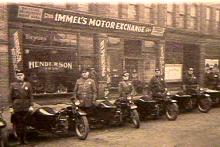
By 1916, many American law enforcement bodies specified the Excelsior X-Twins for their motorcycle patrols. The War Department purchased small quantities of Excelsiors, and the motorcycles were known to have performed well in Pershing's 1916 Mexican campaign and overseas in World War 1.
The Excelsior Lightweight single-cylinder was offered in single- and two-speed models in 1916. The price of the singles increased and may have further lessened already weak consumer interest given the singles' mild performance. This was the last year of the Lightweights. Schwinn disagreed with Henry Ford's statement that a lightweight motorcycle sold at an attractive price would outsell his automobiles. Rather, Schwinn agreed with the President of another motorcycle manufacturer that the three-speed motorcycle had taken its place in the industry and that what Ford heard as a demand for an affordable lightweight was really a demand for a three-speed motorcycle at a reduced price.
Excelsior took one National Championship in 1916, the 10-mile race in Chicago, won by Glenn Stokes on May 30th. The Big Valve X did have important moments at other notable races that year, including a first and second finish by Bob Perry and Glenn Stokes at the Detroit 100-mile flat track race on June 11th. Once again, component manufacturers advertised wins on motorcycles using their products, and the 1916 list included three races won by Perry, and the Pikes Peak Hillclimb won by Floyd Clymer.
 The 1916 Henderson Models F and F2, a single- one and a two-speed respectively, appeared in advertisements in October, 1915. Only the short wheelbase models were available. In the 1916 models, valve size was increased, the hand crank was replaced by a kick starter, and the clutch could be controlled by either a lever on the tank or a foot-operated pedal. By January 20, 1916, advertisements showed an increased price for both the single- and the two-speed models, citing cost increases and shortages in materials and labor due to the war.
The 1916 Henderson Models F and F2, a single- one and a two-speed respectively, appeared in advertisements in October, 1915. Only the short wheelbase models were available. In the 1916 models, valve size was increased, the hand crank was replaced by a kick starter, and the clutch could be controlled by either a lever on the tank or a foot-operated pedal. By January 20, 1916, advertisements showed an increased price for both the single- and the two-speed models, citing cost increases and shortages in materials and labor due to the war.
Police departments, railway companies, and the Post Office Department all ordered Hendersons that year. The popularity of the Henderson continued to increase as Hendersons started showing up as victors in motorcycle club races. Roy Artley began a long series of records for Henderson in 1916, when he set four consecutive records for the San Francisco-to-Los Angeles run.
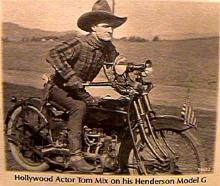
1917
In 1917, the United States was actively involved in World War 1. Motorcycle manufacturers felt the shortage and increased cost of supplies and labor. By mutual agreement, Excelsior and the other two major American motorcycle producers--who, together, were the main factory racing sponsors--refrained from supporting racing. To show their patriotic spirit, Excelsior models for 1917 through 1919 were finished in military olive.
In spite of the war's effect on the industry, Excelsior and Henderson continued developing their motorcycles. The 1917 Henderson Model G was a major advance over the previous year's model. Numerous improvements resulted in an almost entirely new engine that was one of the most advanced of that time. The model G also had a three-speed internal transmission, a left-side mounted kick starter, and improved front forks.
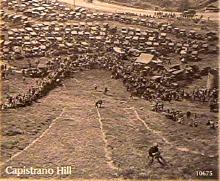 Even with factory sponsorship suspended, 1917 and 1918 were filled with motorcycle competition, setting records in endurance runs, and in hillclimbing. In 1917, C. Lambert won both the stock and free-for-all (professional and amatuer riders competition) hillclimbing events on his Excelsior at Capistrano, California. Later that year, astride his Excelsior, Wells Bennett made the single perfect score at the Los Angeles Motorcycle Club's twelfth annual endurance run.
Even with factory sponsorship suspended, 1917 and 1918 were filled with motorcycle competition, setting records in endurance runs, and in hillclimbing. In 1917, C. Lambert won both the stock and free-for-all (professional and amatuer riders competition) hillclimbing events on his Excelsior at Capistrano, California. Later that year, astride his Excelsior, Wells Bennett made the single perfect score at the Los Angeles Motorcycle Club's twelfth annual endurance run.
Hendersons were also in competition news. In July, 1917, Alan T. Bedell completed the New York-to-Los Angeles coast-to-coast ride on his Henderson in 7 days, 16 hours, and 16 minutes, covering 3,296 miles. Bedell, 21 years old and 180 pounds, he beat the coast-to-coast record by 3 days, 19 hours. In 1917, paved or surfaced roads existed mostly in cities and large towns; cross country roads were generally dirt, gravel, sand, or mud. On his coast-to-coast run, Bendell rode many miles in deep sand or on rock-strewn roads.
 That year, Roy Artley set two important records. He set a new sidecar 24-hour distance record of 706 miles. In July, the same month Bendell made his Three-Flag (Canada-United States-Mexico) run on his stock Henderson, besting by more than eight hours the record held since 1915. The following year, Wells Bennett and his Excelsior, would better Artley's record by over two hours, though Bennett's route was about 50 miles shorter than Artey's.
That year, Roy Artley set two important records. He set a new sidecar 24-hour distance record of 706 miles. In July, the same month Bendell made his Three-Flag (Canada-United States-Mexico) run on his stock Henderson, besting by more than eight hours the record held since 1915. The following year, Wells Bennett and his Excelsior, would better Artley's record by over two hours, though Bennett's route was about 50 miles shorter than Artey's.
By 1917, in spite of the Henderson motorcycle's excellent reputation and strong sales, the Henderson Motorcycle Company was having serious financial difficulty. While Henry Ford purchased a Henderson that year, more and more prospective customers chose products like Ford's over those like Henderson's. With automobiles becoming less expensive and selling in ever-increasing numbers, the motorcycle industry as a whole experienced problems from growing competition.
At the same time, Schwinn was doing well with its finances from its bicycle and motorcycle businesses. Excelsior documents dated March 15, 1917, reveal a complete set of plans for a four-cylinder motorcycle. The plans for the four-cylinder, refered to as Model O, are very similar to those for the Henderson Model K produced in 1920. The Model O had a side-valve engine, ball housing clutch, and three-speed transmission, with front forks identical to the Henderson's. From these plans, it appears Excelsior was poised to enter the four-cylinder market. But the Model O was never produced.

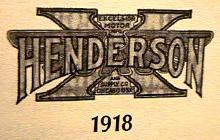
Return to Top
Back to Page 1
Henderson joins the force
On October 1, 1917, the Henderson Motorcycle Company presented Schwinn and the Excelsior Motor Manufacturing and Supply Company with a financial statement and a proposal for the sale of Henderson to Excelsior. Schwinn eagerly jumped at the opportunity to add one of the world's most recognized four-cylinder motorcycles to his stable. Not only did the addition of Henderson fulfil Schwinn's desire to produce a four-cylinder, but Henderson's commitment of building only the highest-quality motorcycles matched his own, and that of Excelsior.
On November 10, the Henderson board of directors approved a resolution to discontinue production, liquidate assets, and pay liabilities. Three days later the board ratified the contract between Excelsior and Henderson and attached its November 10 resolution to the contract. Two days later, on November 15, 1917, Schwinn returned the signed originals of the contract for sale and a certified copy of the Henderson resolution, and authorized execution of the sale contract.
Though the Henderson Company still existed, it no longer produced motorcycles. Tom Henderson joined Excelsior as sales manager and Will came on board as factory superintendent. Tom Henderson's protege engineer Arthur O. Lemon, who had worked at Henderson with Tom, also came to Excelsior.
Schwinn pressed to have Henderson transfer motorcycles, parts, and manufacturing tools as quickly as possible so Excelsior could offer the Henderson brand in 1918. By November 23, 1917, nine boxcars had been loaded in Detroit and shipped to Chicago. Shipping continued as late as December 24, 1917, with jigs and tools arriving with those later shipments. Six complete 1918 Hendersons were shipped to Chicago on December 19. The Chicago factory likely produced very limited numbers of the 1918 Henderson until late December, 1917, when the factory became fully operational.
Part three--1918 thru 1931-- The Glory Continues